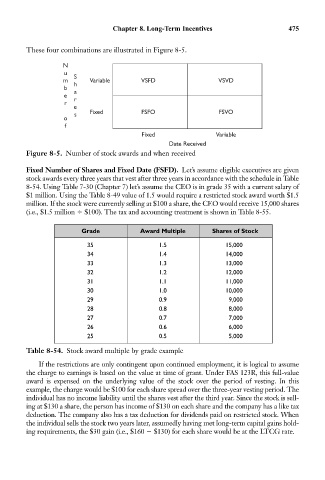Page 489 - Bruce Ellig - The Complete Guide to Executive Compensation (2007)
P. 489
Chapter 8. Long-Term Incentives 475
These four combinations are illustrated in Figure 8-5.
N
u
m S Variable VSFD VSVD
h
b
a
e
r
r
e
Fixed FSFO FSVO
s
o
f
Fixed Variable
Date Received
Figure 8-5. Number of stock awards and when received
Fixed Number of Shares and Fixed Date (FSFD). Let’s assume eligible executives are given
stock awards every three years that vest after three years in accordance with the schedule in Table
8-54. Using Table 7-30 (Chapter 7) let’s assume the CEO is in grade 35 with a current salary of
$1 million. Using the Table 8-49 value of 1.5 would require a restricted stock award worth $1.5
million. If the stock were currently selling at $100 a share, the CEO would receive 15,000 shares
(i.e., $1.5 million $100). The tax and accounting treatment is shown in Table 8-55.
Grade Award Multiple Shares of Stock
35 1.5 15,000
34 1.4 14,000
33 1.3 13,000
32 1.2 12,000
31 1.1 11,000
30 1.0 10,000
29 0.9 9,000
28 0.8 8,000
27 0.7 7,000
26 0.6 6,000
25 0.5 5,000
Table 8-54. Stock award multiple by grade example
If the restrictions are only contingent upon continued employment, it is logical to assume
the charge to earnings is based on the value at time of grant. Under FAS 123R, this full-value
award is expensed on the underlying value of the stock over the period of vesting. In this
example, the charge would be $100 for each share spread over the three-year vesting period. The
individual has no income liability until the shares vest after the third year. Since the stock is sell-
ing at $130 a share, the person has income of $130 on each share and the company has a like tax
deduction. The company also has a tax deduction for dividends paid on restricted stock. When
the individual sells the stock two years later, assumedly having met long-term capital gains hold-
ing requirements, the $30 gain (i.e., $160 $130) for each share would be at the LTCG rate.

